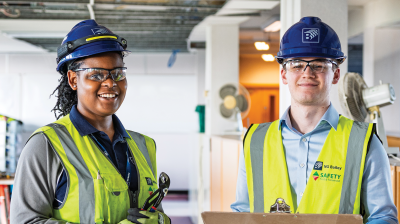27 Sep 2023
On the road to net zero, science-based targets lead the way

In the article below, Sarah Hotchen, Managing Director Facilities Services, talks about how the journey to net zero is a collective one across all industries.
Back in 2018, the Intergovernmental Panel on Climate Change warned that global warming must not exceed 1.5°C to avoid the catastrophic impacts of climate change. To achieve this, emissions must halve by 2030 and reduce to net zero by 2050. Now, we’re halfway through 2023, the deadline for reducing emissions by 50 per cent is getting every closer with the net zero goal not much further behind.
The journey to net zero is not one industry’s cross to bear; it’s a path which the entire world must walk together. However, when you consider that the building sector is responsible for 36 per cent of the world’s final energy consumption, and 37 per cent of global energy-related carbon dioxide emissions, it’s clear that our industry can have a big impact in the path to achieving net zero. This is exactly why the Science Based Targets initiative (SBTi) was developed, to enable organisations to drive ambitious climate action through setting science-based emissions reduction targets.
The SBTi works with companies and financial institutions to aid them in developing a clear roadmap and timeframe to reducing their greenhouse gas (GHG) emissions. This roadmap acts as a measure of accountability and transparency, working alongside wider corporate net zero agendas and ESG strategies.
At NG Bailey we’re tackling this challenge head on, being amongst the first 10 UK construction, engineering and services businesses to have a science-based target with a 1.5°C near term and net zero commitment approved by the SBTi. We have committed to reducing our absolute Scope 1 and Scope 2 GHG emissions – which covers the emissions from sources we own and control directly, as well as those we cause indirectly – by 50 per cent by 2031.
We have also committed to making reductions in our scope 3 emissions, which covers the emissions of our suppliers further down the supply chain. The target we have set will ensure 75 per cent of our suppliers, covering purchased goods, services and capital goods, will have science-based targets by 2027, demonstrating they are committed to going on the same journey as we are.
NG Bailey has already reduced our absolute emissions by 27 per cent, however we know this is just the beginning of our journey. Through our market-leading net positive responsibility strategy we’ve developed a clear roadmap to reaching our longer-term goals, in line with our SBTi approved targets.
Our strategy’s six key pillars of zero carbon, zero waste, zero harm, sustainable growth, delivering social value and being a great place to work ensure we deliver on our goal of putting more into society, the environment and the global economy than we take out. The development of this strategy has expanded our expertise, providing us with opportunities to advise and offer solutions for clients, many of whom are on their own sustainability journeys.
The Net Positive responsibility strategy has proven to be a holistic approach. It’s involved helping clients understand how to reach their emissions targets in a variety of areas, from sustainable MEP (mechanical, electrical and plumbing) solutions to utilising less carbon intensive methods of construction, such as offsite manufacturing.
We’ve only been able to guide our clients on their own journeys by thoroughly scrutinising our own ways of working. The measures which we advise our clients to take, are the very same we’re implementing across our own business. We’re seeking to reduce our carbon impact which includes switching to 100 per cent renewable energy across our owned estate, as well as seeking alternative fuels for plant use and further developing our expertise in MMC (modern methods of construction).
Delivering ambitious science-based targets may at times seem impossible, but that’s exactly why committing to them is crucial. It is through these commitments to change our methods and to reduce GHG emissions that we will see tangible change in the industry.
Taking the initial, intimidating steps to getting our science-based targets approved, has enabled us to develop a clear roadmap to a more sustainable future. Now, we’re not only reducing our own emissions but are able to offer innovative sustainability measures to be used across the industry. The journey to net zero is a collective one, and it is through collaboration, influence, and innovation that we can begin to make a net zero future a reality.

























